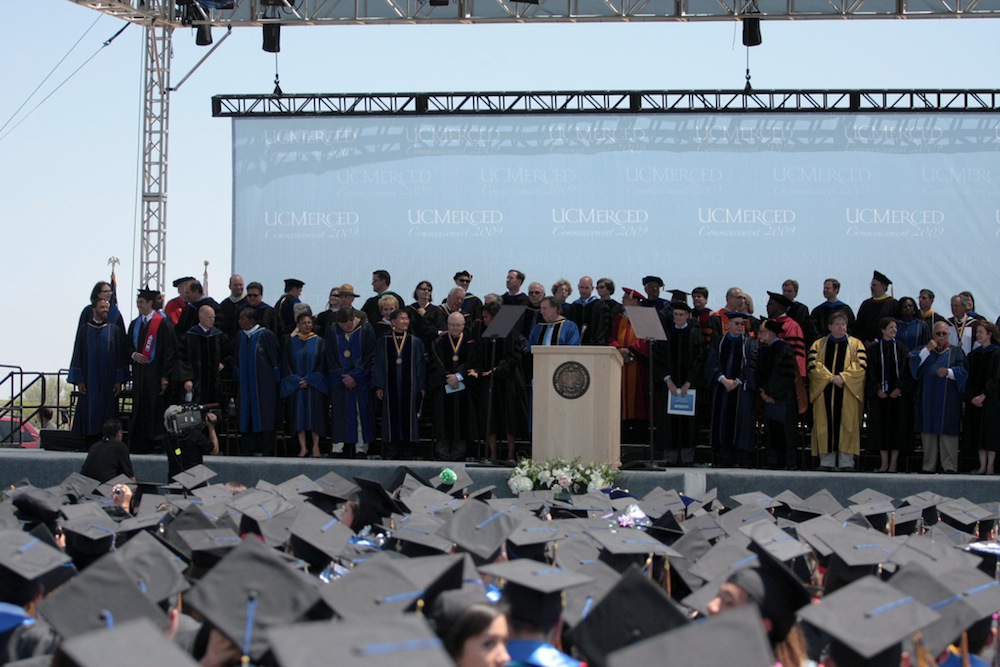
At commencement this past weekend, UC Merced sent a crop of about 1,100 graduates off into the world. Six years ago, when we awarded degrees to our first full graduating class, we had just under 300. That’s a sign of our growth, but more importantly—of demand.
Last fall, we received more than 20,000 applications, but we had seats for fewer than 10 percent of them. Much of that demand comes from populations that historically have not sent large numbers to the UCs – students from the San Joaquin Valley, for instance. In fact, since UC Merced opened, high school applications to the entire UC system from the San Joaquin Valley have doubled. More than half of our students come from low-income families and more than 45 percent are Latino.
We want to nurture this college-going culture among populations that haven’t historically graduated from the UCs in numbers that reflect their role in the state. Jessica Rivas, for example, never planned to go to college. When she was in high school in North Hollywood, a close family member was diagnosed with serious mental illness and she found a deeply personal reason to want to learn more about how the brain works.
Rivas, a cognitive science major who graduated this weekend, was like six out of 10 of her peers here, the first in her family to attend a four-year university. And with each new example of a graduate in communities that haven’t had a college-going culture, we’ve seen that graduate inspires multiple others to think that college is within reach.
UC Merced was founded in 2005 with the firm belief that our state’s future rests on a new generation of Californians like Rivas—bright and capable young men and women who have so much to contribute if simply given a chance.
As a native of the rural Ventura County community of Fillmore, I knew what the success of this young university would mean to the generations of students, who like me, needed only the appropriate educational opportunity to be able to fulfill their professional dreams and give back to their state and communities.
In our classrooms, residence halls, and labs, you can see the future of California. As the most diverse campus in the UC system, the UC Merced of 2015 is the California of 2035. And this is good news for all Californians, including the many historically underserved students who now benefit from access to a UC quality education.
The carefully considered decision to locate the 10th UC campus in the fast-growing San Joaquin Valley has paid big economic dividends for the region, as well.
In an area that has struggled for decades with high rates of poverty, unemployment, and economic stagnation, UC Merced has created not only faculty and staff positions, but thousands of new jobs in K-12 teaching, accounting, childcare, construction and other fields. Research expenditures in everything from drones to solar energy have totaled around $126 million since 2000. The university has also invested more than $1.1 billion in the region, and $2.2 billion statewide, through construction contracts awarded, wages and benefits paid, and goods and services purchased.
And we are training students in issues with real-world implications facing California and the world. For example, the Sierra Nevada Research Institute is discovering and disseminating new knowledge about sustaining natural resources such as air, water and soil in the Southern Sierra Nevada. UC Merced is also the home of the UC Advanced Solar Technologies Institute, which is helping to make renewables more efficient and affordable.
We are extremely proud of these achievements and what they say about the UC system’s role in California’s success. Yet at a time of so much promise, we are struggling to meet the surging demand because our campus is fast approaching the limits of its physical capacity, and there is a lack of state funding to expand our facilities.
Already, many of our students attend classes late into the night to make the most of class space, professors keep office hours in noisy public spaces, and lab space is used as makeshift desks. In student housing, we have squeezed three beds in spaces for two and four beds in spaces for three.
We are trying to do more with less in this period of uncertain state funding: we’re already planning to add classrooms, research labs, and housing through a partnership with the private sector that we call the 2020 Project. It will enable us to build facilities to accommodate up to 10,000 students by the beginning of the next decade. In an approach recently endorsed by the Bay Area Council Economic Institute, UC Merced can focus public resources on educational priorities such as maintaining access, while private dollars can be used to fund construction.
Californians need to reinvest in their world-class educational system because it lays the foundation of our prosperity and success. We need graduates with know-how and a sense of responsibility like Ruben Reyes, a 19-year-old sophomore from La Puente who is also the first in his family to attend college.
Reyes, a psychology major, is a volunteer with the Merced County Project 10 Percent, which is trying to address Merced’s dropout crisis, and visits middle schools to encourage students to stay in school. And after he graduates, he plans to return to Los Angeles and work in his home community.
Just imagine what this state’s future would look like if the potential of students such as Reyes and Rivas went untapped. Our state can’t afford to leave any UC-eligible young person behind. What’s the point in making such a bold investment in a world-class higher-education system if we can’t reap all the benefits?




Send A Letter To the Editors